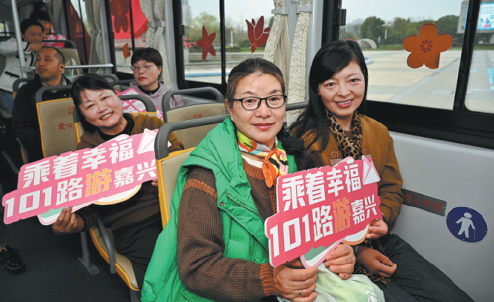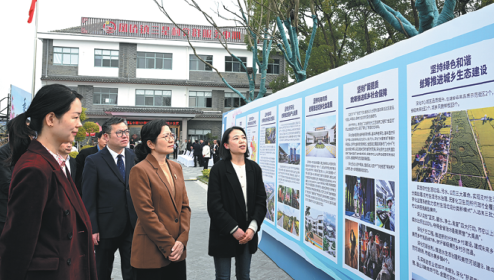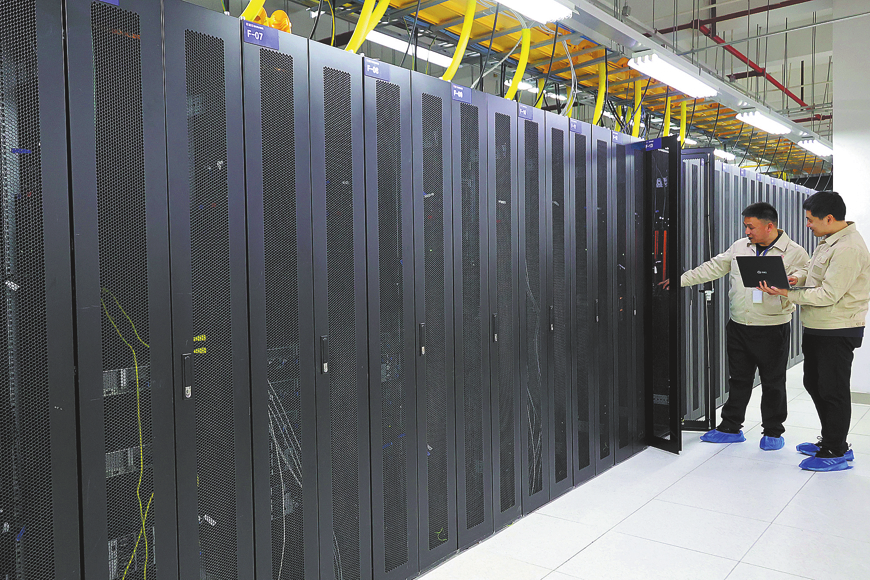Jiaxing bus is a ticket to prosperity
Urban-rural network has changed the face of the countryside, Yang Feiyue reports.

A brightly-colored bus emblazoned with the slogan "driving to happiness" has been parked at the entrance of Sanxing village since late March, luring visitors to the village in Fengqiao town, in Jiaxing, Zhejiang province. Vivid illustrations and texts on board immediately take you down the road of coordinated urban and rural development across the region.
"It's pretty much how I feel about the changes over the years," says Wang Wanling, who now lives in downtown Jiaxing but previously lived in Yonghong village, about 5 kilometers from Sanxing.
"Nowadays, the countryside has really changed a lot. The roads are wider, the water is clearer, and the air is fresher," Wang says.
The authorities chose the No 101 bus to host the exhibition because it was the first public link to connect urban and rural areas in Jiaxing two decades ago, and has borne witness to the city's synchronized urban and rural development.
At the beginning of reform and opening-up in 1978, residents in Jiaxing primarily relied on boats to travel, due to the area's extensive river networks.
Public buses began to run in the downtown area in 1984 and took over the main role in transportation after roads and bridges were built, as they were much faster than boats.
However, rural residents had to rely on privately-owned buses to visit the downtown area to do things like selling farm produce, says Shen Shuigen, who used to run such a service in 1997.
The drawbacks of rural buses became increasingly apparent. There were no fixed stations or departure times, ticket prices were generally determined by market demand, and sometimes there were issues with overloading, Shen says.
To solve the problem, more than 200 private buses were taken over by the local government-funded public transportation company.
Shen became a driver for the company.
"I was thinking long-term. I got insurance and housing funds, as well as a higher salary and benefits," Shen says, explaining why he accepted the offer.
"It's better this way, the government taking the lead, so that things are standardized and made convenient and affordable for common people," he says.
In 2003, the No 101 bus was introduced to address those problems, cutting the commute time between many villages and the city area.
Zhang Xiuzhen from Sanxing still takes the bus several times a week to purchase groceries downtown.
"It takes only about 40 minutes to get there, and I can still make it back home for lunch, which is very convenient," Zhang says.
She has also seen changes to the operation of the No 101 bus.
"In the past, the bus was small and crowded, and it took much more time to get to the city. Now, it's spacious, the waiting time is much shorter, and the ticket is cheap, only 2 yuan ($0.28) to get to the city," Zhang says, adding that the scenery along the route has also changed significantly.
The 101 bus runs 24 kilometers through more than 30 stations, including a train station, the site of the First National Congress of the Communist Party of China, and the city's central park.
"You can see towering buildings on one side of the road and vast, fertile fields on the other, a balance of bustling metropolis and tranquil home," Zhang says, describing the journey.
The 101 bus is one part of a well-developed public transport system that covers all major towns and villages.
It has not just made commuting easier, but has brought positive change to rural areas.
Fengqiao has been known for its sweet, juicy peaches for over a century. But 10 years ago, underdeveloped public transport kept the fruit from being known outside.
"We had to take a boat to the market to sell our peaches, it was a long journey, and arduous," says Ying Huaxing, a peach farmer from Sanxing village.
The five bus stations in the village now enable him to reach urban customers more easily.
"We can take peach samples on the bus to urban areas to negotiate. After reaching an agreement, we can ship directly in large quantities. We've bid farewell to the days of selling peaches by the roadside," says Ying, who has been selling the fruit with his father since he was a teenager.
This new approach has boosted sales and encouraged him to help improve local peach growing skills, becoming a village expert.
"If anyone in the village has problems growing peaches, they come to me for advice. Whether it's about seedling supply, pest control, technical management or sales channels, I'm happy to help them all," Ying says, adding that seeing fellow villagers growing premium-quality peaches and making more money gives him a great sense of achievement.
Additionally, easy public access means more urban travelers visiting the villages.
"They come here to pick peaches and enjoy countryside fun, which in turn drives up our prices," says Xu Lijun, Sanxing village Party secretary.
Together with the other fruits grown in the village, the total output value of Sanxing's farm produce has reached 180 million yuan ($24.9 million) a year, according to village authorities.
"Now, per capita disposable income in Sanxing has reached 58,000 yuan, and more than 90 percent of all households have an annual income of over 200,000 yuan," Xu says.
The reform of urban and rural public transportation is a microcosm of Jiaxing's coordinated urban-rural development.
In 2004, the city took the lead among prefectural-level cities nationwide in issuing the outline of an urban-rural integration development plan, which proposed deepening the reform of urban-rural integration and narrowing the urban-rural gap.
The outline's goal was the comprehensive, coordinated, and sustainable development of the economy, social affairs, culture, and environment of urban and rural areas.
In 2022, the per capita disposable income of rural residents in Jiaxing was 46,276 yuan and has been the highest in Zhejiang for 19 consecutive years, according to a report from the Jiaxing government.
The income ratio between urban and rural residents has narrowed to within 1.6 percent, and the urban-rural gap is the smallest in the province.
Tang Zhiyun, who lives near the Yuxin town government, four bus stops from Sanxing village, says she has come to feel fortunate to be a villager in Jiaxing.
"In the past, I always wanted to be a city dweller, but now I feel that my life is not much different from theirs. Sometimes, even city dwellers envy us," she says.
In March, local officials announced a plan to establish a common wealth service circle, where 11 regular programs will be implemented.
They include both "Red" (of the country's revolutionary culture and heritage) and rural tourism bus routes, health service stations, and local student internships, says Zhu Jianhua, a senior official at the Jiaxing Communication Investment Group.
"We will leverage resources from all parties to meet the needs of the people, and collectively strive for a better life," Zhu says.




Today's Top News
- Experts share ideas on advancing human rights
- Japan PM's remarks on Taiwan send severely wrong signal
- Key steps to boost RMB's intl standing highlighted
- Sustained fight against corruption urged
- Xi calls for promotion of spirit of volunteerism
- Xi calls for promoting volunteer spirit to serve national rejuvenation






























